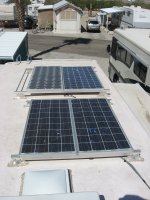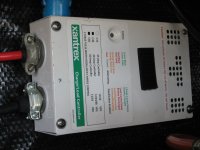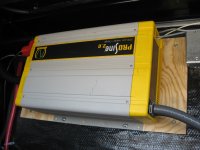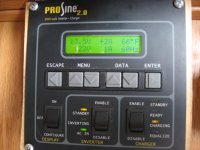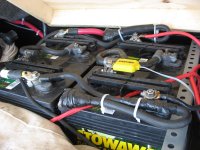Solar panel and inverter wiring
I have two 120 watt panels on the roof of my 3055RL. I ran 10 gage wire down the washer/dryer vent located on the front right side of the roof. By cutting the vent pipe in the front closet I was able to fish the wires through the pipe and out to my solar regulator which I located on the closet sidewall. From the street side front battery/hydraulic compartment I found an existing hole in the top that went through the bedroom floor and came out in the the wire passage-way underneath the bedroom chest-of-drawers (I would have drilled a hole up in this location, but found one there already). By removing the front bottom lower drawer, I was able to feed up two conductor 10 gage stranded solar wire from the bottom.I bent it slightly so it would go forward when pushing from the bottom. It was easy to find the wire with the drawer out of the way, then route the wire through the access hole leading to the closet area where my solar regulator is located.
The wires in the front compartment are connected to the the batteries via the factory battery terminations. The result was a very neat installation.
I mounted my 1750 watt inverter in the front wall of the basement storage compartment and was able to feed the big inverter input cables through the existing access hole used for backup access to the hydraulic pump ( I still have enough space in the hole to allow use of the drill backup drive to the pump). I wired the inverter output to a 50 amp transfer switch which I mounted on the back wall of the basement storage compartment. I used the existing vent on that wall to feed the wires between the fuse box, input power cord and inverter.
To complete installation of transfer switch wiring, I removed the fuse box from the bottom wall by the entrance door, which gave me room to work. Then I removed the shore power input wires from the fuse box and wired them to the normally open side of the transfer switch input. I wired the normally closed transfer switch input to the inverter output. Finally, I wired the transfer switch output to the fuse box 50 amp input where the power cord was originally connected.
I put the inverter remote control switch below the fantastic vent control on the side wall going up to the bedroom, then put fuse box back in its original location. Everything looks like it belongs there and the only change you can see inside the trailer is the inverter control switch.
With the transfer switch, if shore power is not connected the inverter powers the AC; while, if shore power is connected it powers the AC.
I wired the inverter into only one phase of AC so that the inverter can't power the air conditioner or the converter (I had to switch the phase the converter was wired to accomplish this, I did this by moving it to a different circuit breaker within the fuse box. This is easy to do when you have the fuse box out. I swapped it with a circuit similar in power demand).
Chuck Keskimaki
2010 Bighorn 3055RL, 2001 Chevrolet 2500HD D/A

